2022 TOYOTA COROLLA child restraint
[x] Cancel search: child restraintPage 47 of 678
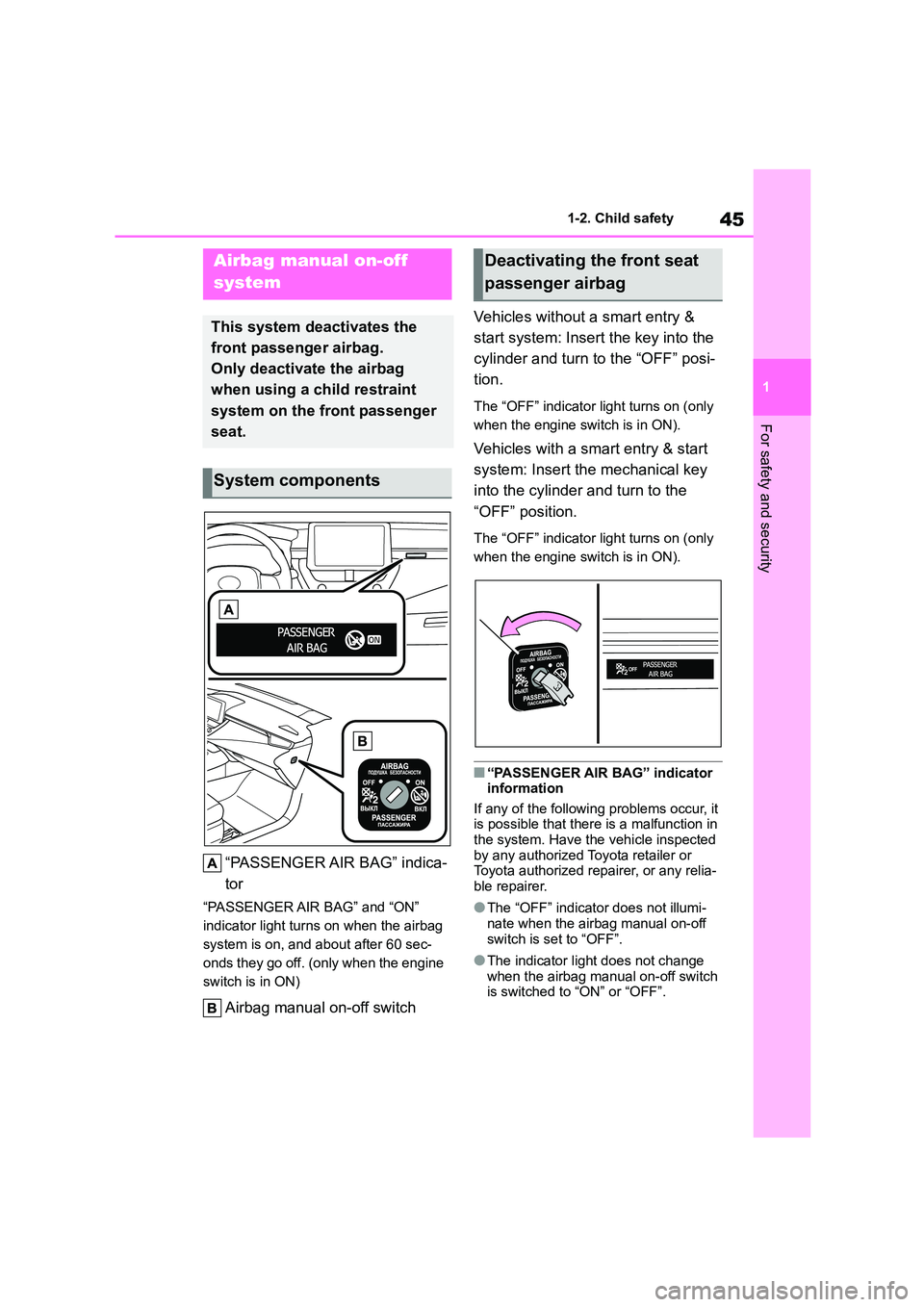
45
1
1-2. Child safety
For safety and security
1-2.Child safety
“PASSENGER AIR BAG” indica-
tor
“PASSENGER AIR BAG” and “ON”
indicator light turns on when the airbag
system is on, and about after 60 sec-
onds they go off. (only when the engine
switch is in ON)
Airbag manual on-off switch
Vehicles without a smart entry &
start system: Insert the key into the
cylinder and turn to the “OFF” posi-
tion.
The “OFF” indicator light turns on (only
when the engine switch is in ON).
Vehicles with a smart entry & start
system: Insert the mechanical key
into the cylinder and turn to the
“OFF” position.
The “OFF” indicator light turns on (only
when the engine switch is in ON).
■“PASSENGER AIR BAG” indicator information
If any of the following problems occur, it
is possible that there is a malfunction in the system. Have the vehicle inspected
by any authorized Toyota retailer or
Toyota authorized repairer, or any relia- ble repairer.
●The “OFF” indicator does not illumi-
nate when the airbag manual on-off switch is set to “OFF”.
●The indicator light does not change when the airbag manual on-off switch
is switched to “ON” or “OFF”.
Airbag manual on-off
system
This system deactivates the
front passenger airbag.
Only deactivate the airbag
when using a child restraint
system on the front passenger
seat.
System components
Deactivating the front seat
passenger airbag
Page 48 of 678
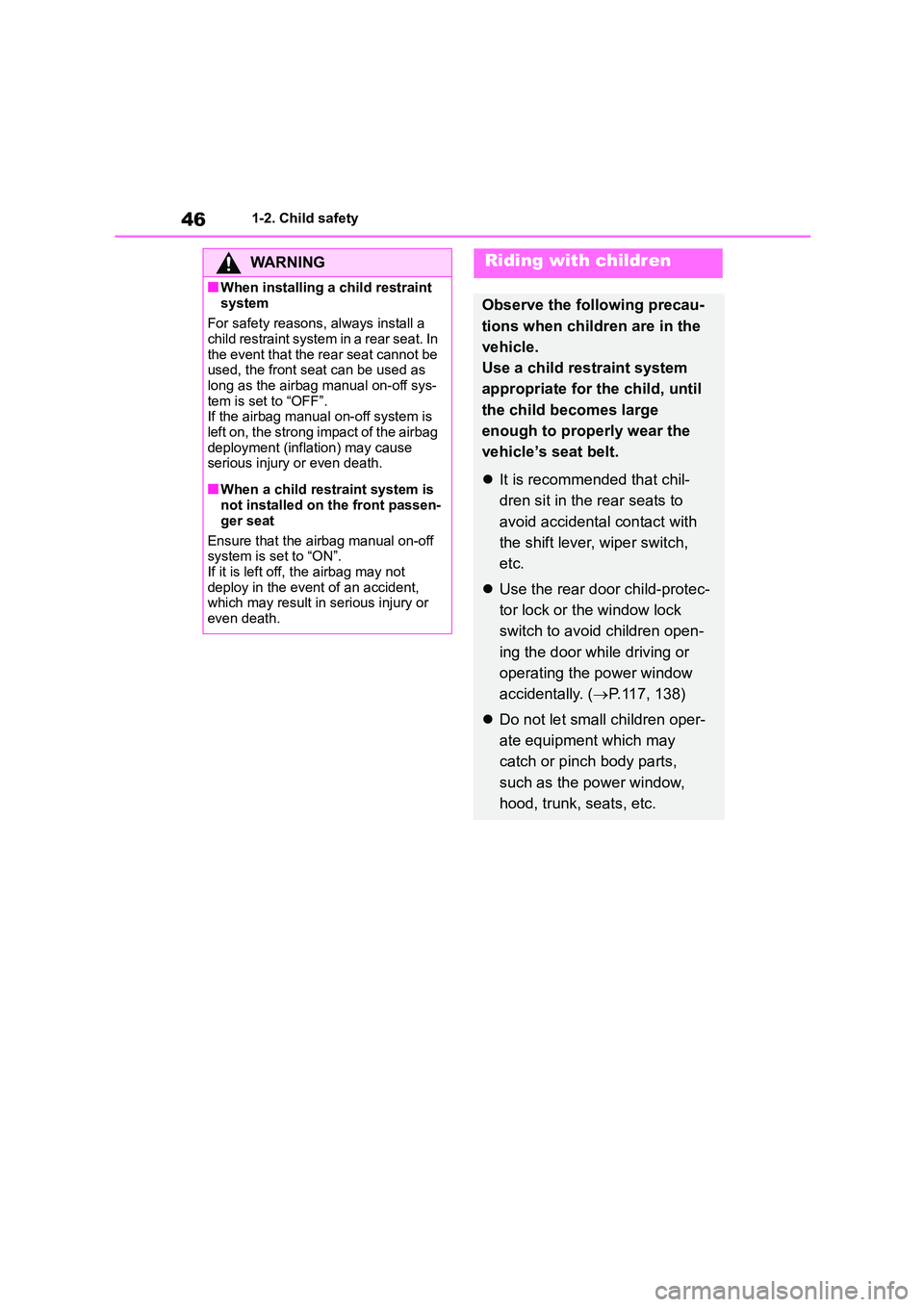
461-2. Child safety
WA R N I N G
■When installing a child restraint
system
For safety reasons, always install a child restraint system in a rear seat. In
the event that the rear seat cannot be
used, the front seat can be used as long as the airbag manual on-off sys-
tem is set to “OFF”.
If the airbag manual on-off system is
left on, the strong impact of the airbag deployment (inflation) may cause
serious injury or even death.
■When a child restraint system is
not installed on the front passen-
ger seat
Ensure that the airbag manual on-off
system is set to “ON”.
If it is left off, the airbag may not deploy in the event of an accident,
which may result in serious injury or
even death.
Riding with children
Observe the following precau-
tions when children are in the
vehicle.
Use a child restraint system
appropriate for the child, until
the child becomes large
enough to properly wear the
vehicle’s seat belt.
It is recommended that chil-
dren sit in the rear seats to
avoid accidental contact with
the shift lever, wiper switch,
etc.
Use the rear door child-protec-
tor lock or the window lock
switch to avoid children open-
ing the door while driving or
operating the power window
accidentally. ( P.117, 138)
Do not let small children oper-
ate equipment which may
catch or pinch body parts,
such as the power window,
hood, trunk, seats, etc.
Page 49 of 678
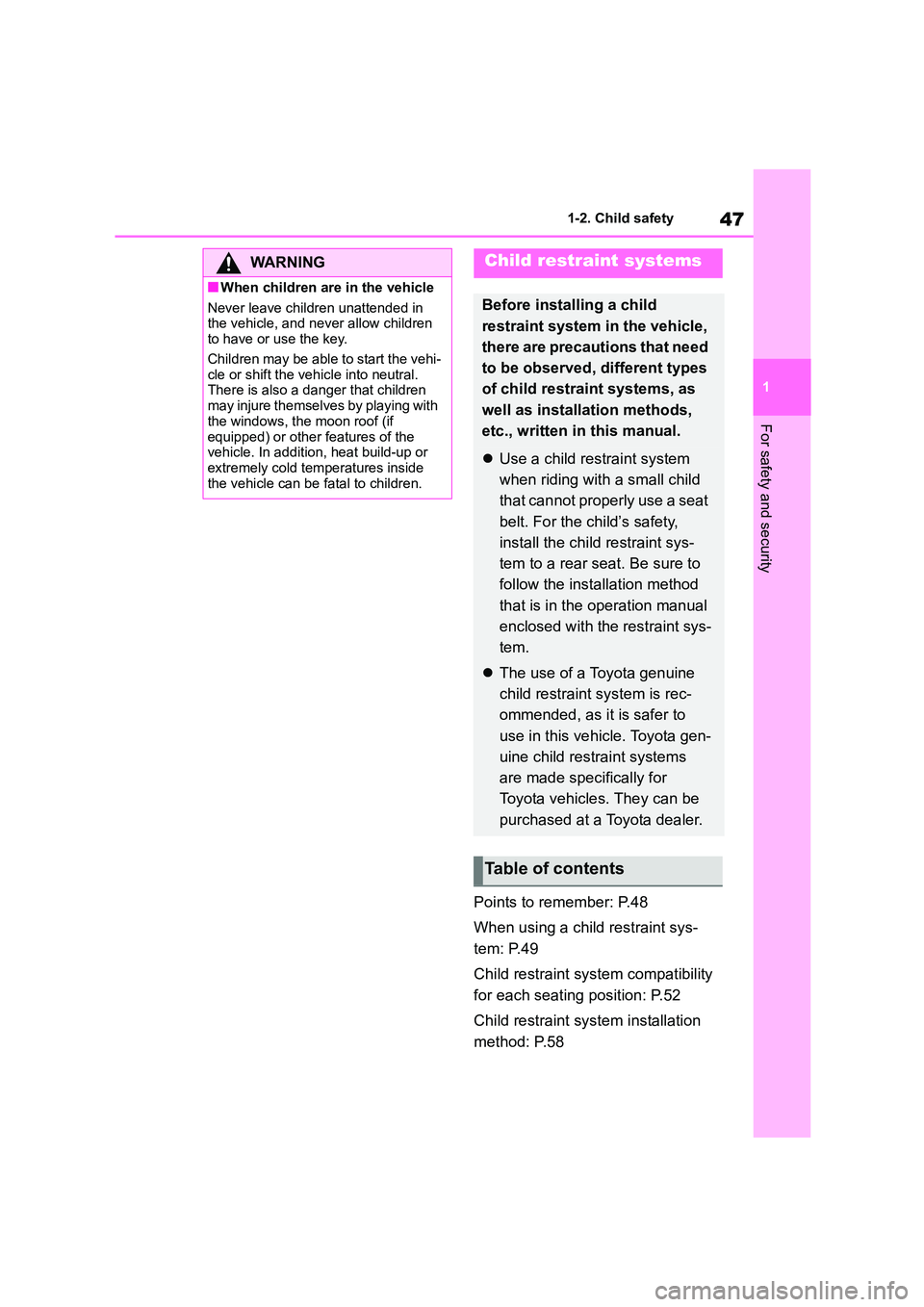
47
1
1-2. Child safety
For safety and security
Points to remember: P.48
When using a child restraint sys-
tem: P.49
Child restraint sys tem compatibility
for each seating position: P.52
Child restraint sys tem installation
method: P.58
WA R N I N G
■When children are in the vehicle
Never leave children unattended in
the vehicle, and never allow children to have or use the key.
Children may be able to start the vehi-
cle or shift the vehicle into neutral. There is also a danger that children
may injure themselves by playing with
the windows, the moon roof (if
equipped) or other features of the vehicle. In addition, heat build-up or
extremely cold temperatures inside
the vehicle can be fatal to children.
Child restraint systems
Before installing a child
restraint system in the vehicle,
there are precautions that need
to be observed, different types
of child restraint systems, as
well as installation methods,
etc., written in this manual.
Use a child restraint system
when riding with a small child
that cannot properly use a seat
belt. For the child’s safety,
install the child restraint sys-
tem to a rear se at. Be sure to
follow the insta llation method
that is in the operation manual
enclosed with the restraint sys-
tem.
The use of a Toyota genuine
child restraint system is rec-
ommended, as it is safer to
use in this vehicle. Toyota gen-
uine child restraint systems
are made specifically for
Toyota vehicles. They can be
purchased at a Toyota dealer.
Table of contents
Page 50 of 678
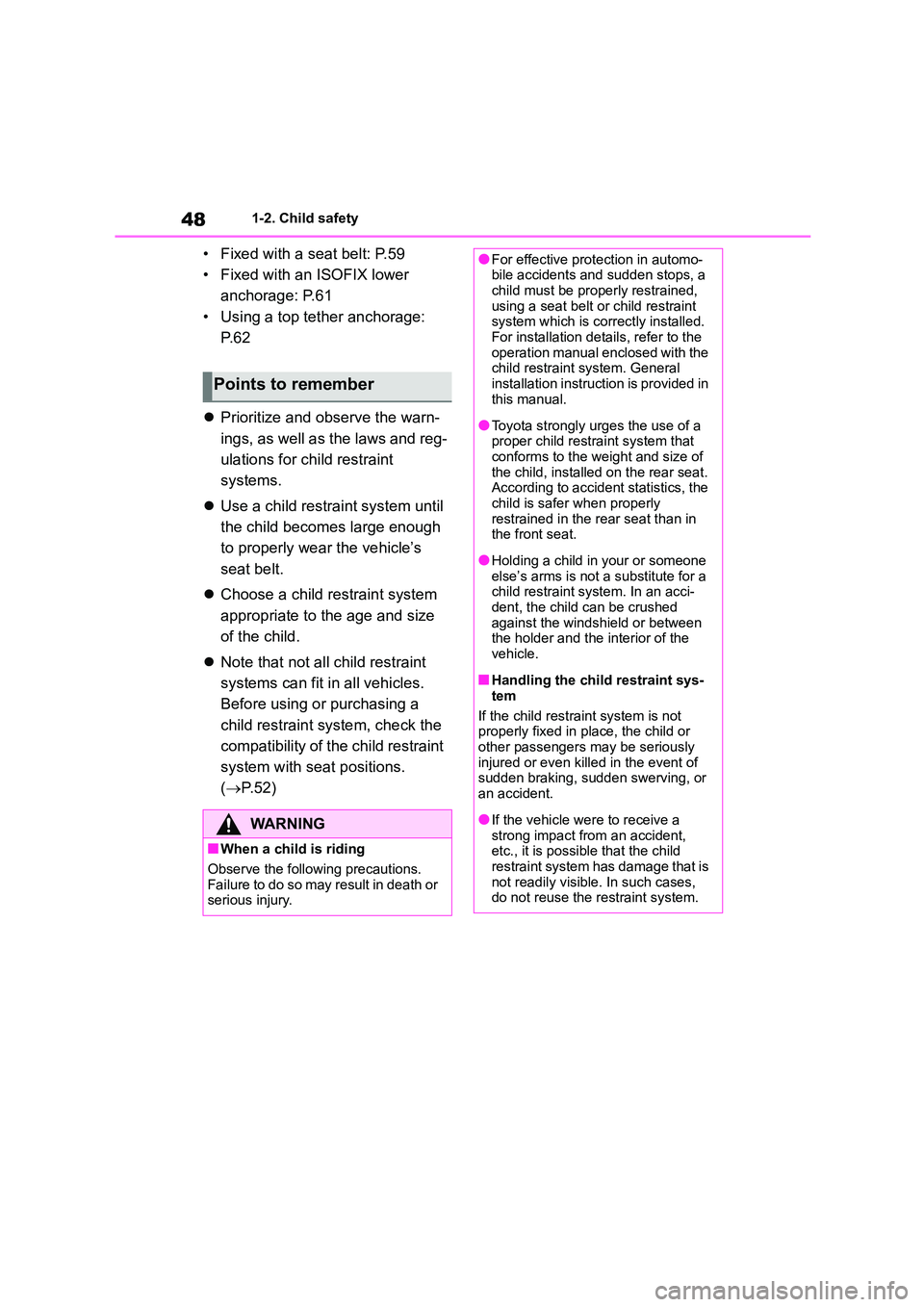
481-2. Child safety
• Fixed with a seat belt: P.59
• Fixed with an ISOFIX lower
anchorage: P.61
• Using a top tether anchorage:
P. 6 2
Prioritize and observe the warn-
ings, as well as the laws and reg-
ulations for child restraint
systems.
Use a child restraint system until
the child becomes large enough
to properly wear the vehicle’s
seat belt.
Choose a child restraint system
appropriate to the age and size
of the child.
Note that not all child restraint
systems can fit in all vehicles.
Before using or purchasing a
child restraint system, check the
compatibility of th e child restraint
system with seat positions.
( P. 5 2 )
Points to remember
WA R N I N G
■When a child is riding
Observe the following precautions.
Failure to do so may result in death or
serious injury.
●For effective protection in automo- bile accidents and sudden stops, a
child must be properly restrained,
using a seat belt or child restraint system which is corr ectly installed.
For installation details, refer to the
operation manual enclosed with the child restraint system. General
installation instruction is provided in
this manual.
●Toyota strongly urges the use of a
proper child rest raint system that conforms to the weight and size of
the child, installed on the rear seat.
According to accident statistics, the child is safer when properly
restrained in the rear seat than in
the front seat.
●Holding a child in your or someone
else’s arms is not a substitute for a child restraint system. In an acci-
dent, the child can be crushed
against the windshield or between the holder and the interior of the
vehicle.
■Handling the child restraint sys-
tem
If the child restraint system is not properly fixed in place, the child or
other passengers may be seriously
injured or even killed in the event of sudden braking, sudden swerving, or
an accident.
●If the vehicle were to receive a
strong impact from an accident,
etc., it is possible that the child restraint system has damage that is
not readily visible. In such cases,
do not reuse the restraint system.
Page 51 of 678
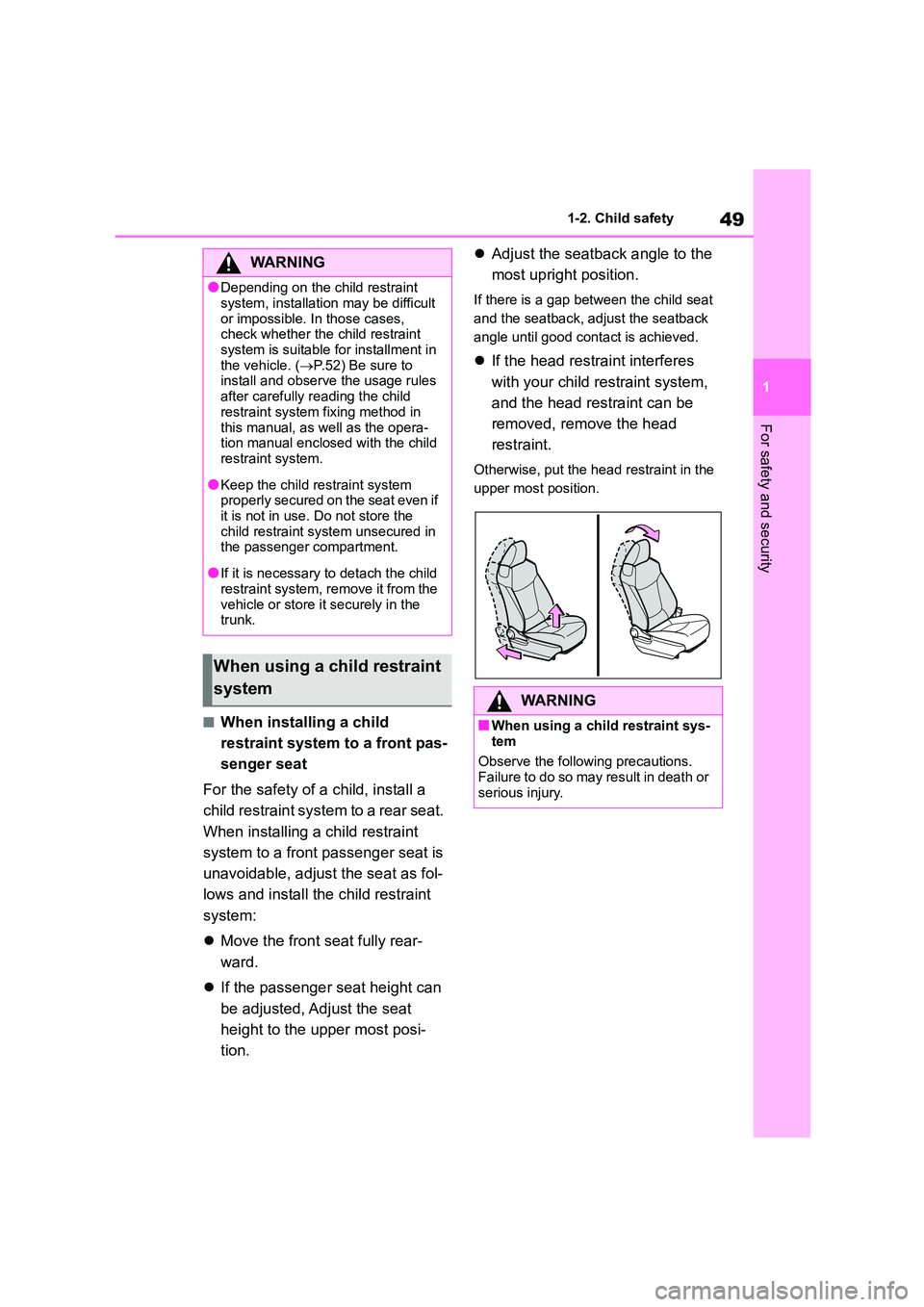
49
1
1-2. Child safety
For safety and security
■When installing a child
restraint system to a front pas-
senger seat
For the safety of a child, install a
child restraint system to a rear seat.
When installing a child restraint
system to a front passenger seat is
unavoidable, adjust the seat as fol-
lows and install t he child restraint
system:
Move the front seat fully rear-
ward.
If the passenger seat height can
be adjusted, Adjust the seat
height to the upper most posi-
tion.
Adjust the seatback angle to the
most upright position.
If there is a gap between the child seat
and the seatback, adjust the seatback
angle until good contact is achieved.
If the head restraint interferes
with your child restraint system,
and the head restraint can be
removed, remove the head
restraint.
Otherwise, put the head restraint in the
upper most position.
WA R N I N G
●Depending on the child restraint
system, installation may be difficult
or impossible. In those cases, check whether the child restraint
system is suitable for installment in
the vehicle. ( P.52) Be sure to install and observe the usage rules
after carefully reading the child
restraint system fixing method in
this manual, as well as the opera- tion manual enclosed with the child
restraint system.
●Keep the child re straint system
properly secured on the seat even if
it is not in use. Do not store the child restraint system unsecured in
the passenger compartment.
●If it is necessary to detach the child
restraint system, remove it from the
vehicle or store it securely in the trunk.
When using a child restraint
systemWA R N I N G
■When using a child restraint sys-
tem
Observe the following precautions. Failure to do so may result in death or
serious injury.
Page 52 of 678

501-2. Child safety
WA R N I N G
●Never use a rear-facing child
restraint system on the front pas-
senger seat when the airbag man- ual on-off switch is on. ( P.45) The
force of the rapid inflation of the
front passenger airbag can cause death or serious injury to children in
the event of an accident.
●There is a label(s) on the passen- ger side sun visor, indicating it is
forbidden to attach a rear-facing
child restraint system to the front passenger seat.
Details of the label(s) are shown in
the illustration below.
Page 53 of 678

51
1
1-2. Child safety
For safety and security
WA R N I N G
WA R N I N G
●Only put a forward-facing child
restraint system on the front seat
when unavoidable. When installing a forward-facing child restraint on
the front passenger seat, move the
seat as far back as possible. Failing to do so may result in death or seri-
ous injury if the airbags deploy
(inflate).
●Vehicles with SRS side airbags or
SRS curtain shield airbags: Do not
allow the child to lean his/her head or any part of his/her body against
the door or the area of the seat,
front or rear pillars, or roof side rails
from which the SRS side airbags or SRS curtain shield airbags deploy
even if the child is seated in the
child restraint system. It is danger- ous if the SRS side and curtain
shield airbags inflate, and the
impact could cause death or seri- ous injury to the child.
●When a junior seat is installed, always ensure that the shoulder
belt is positioned across the center
of the child’s shoulder. The belt should be kept away from the
child’s neck, but not so that it could
fall off the child’s shoulder.
Page 54 of 678
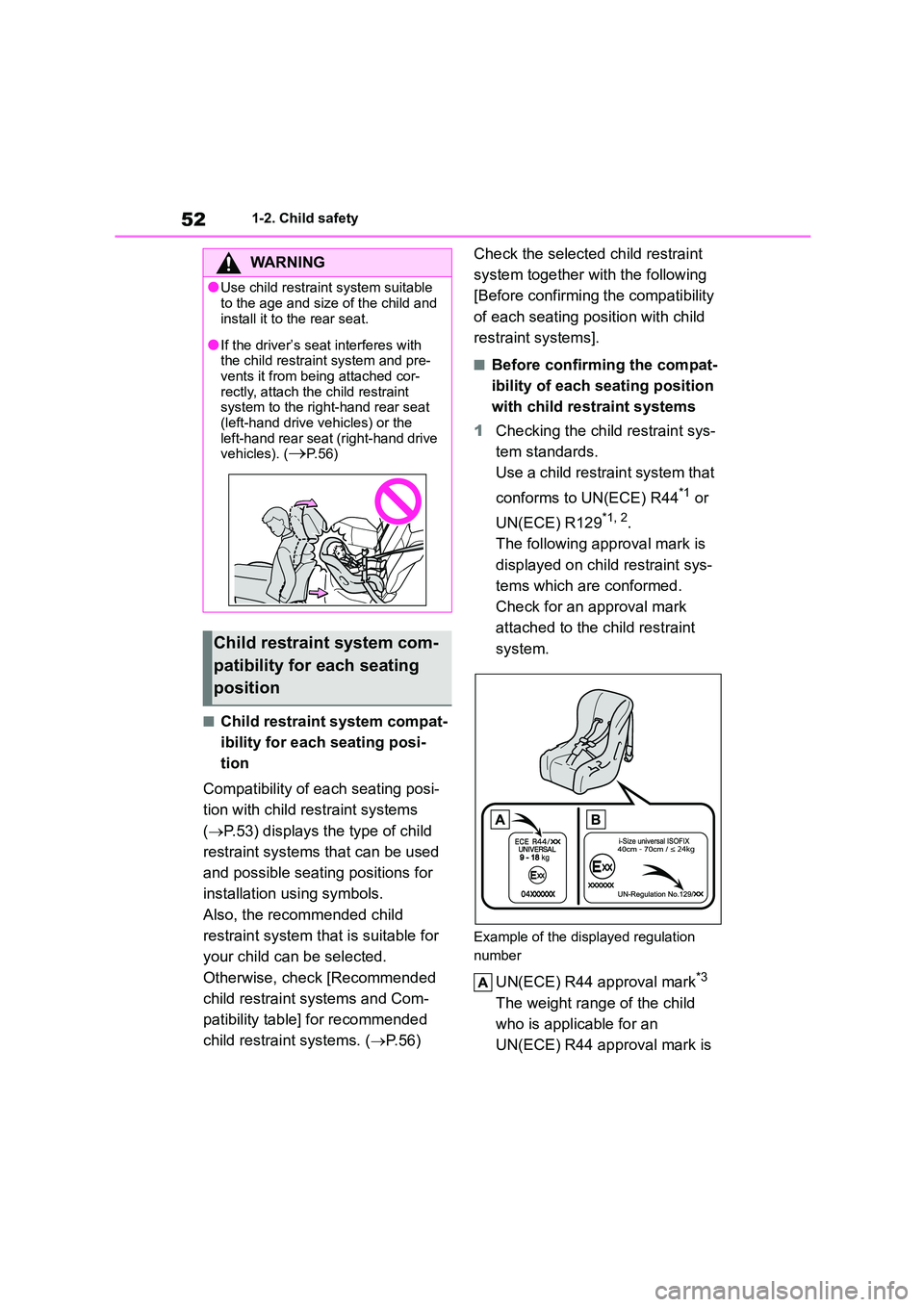
521-2. Child safety
■Child restraint system compat-
ibility for each seating posi-
tion
Compatibility of eac h seating posi-
tion with child restraint systems
( P.53) displays the type of child
restraint systems that can be used
and possible seating positions for
installation using symbols.
Also, the recommended child
restraint system that is suitable for
your child can be selected.
Otherwise, check [Recommended
child restraint systems and Com-
patibility table] for recommended
child restraint systems. ( P. 5 6 )
Check the selected child restraint
system together with the following
[Before confirming the compatibility
of each seating position with child
restraint systems].
■Before confirming the compat-
ibility of each seating position
with child restraint systems
1 Checking the child restraint sys-
tem standards.
Use a child restraint system that
conforms to UN(ECE) R44*1 or
UN(ECE) R129*1, 2.
The following approval mark is
displayed on child restraint sys-
tems which are conformed.
Check for an approval mark
attached to the child restraint
system.
Example of the displayed regulation
number
UN(ECE) R44 approval mark*3
The weight range of the child
who is applicable for an
UN(ECE) R44 approval mark is
WA R N I N G
●Use child restraint system suitable
to the age and size of the child and
install it to the rear seat.
●If the driver’s seat interferes with
the child restraint system and pre- vents it from being attached cor-
rectly, attach the child restraint
system to the righ t-hand rear seat
(left-hand drive vehicles) or the left-hand rear seat (right-hand drive
vehicles). (P. 5 6 )
Child restraint system com-
patibility for each seating
position